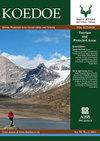Elephant population responses to increased density in Kruger National Park
IF 1.1
4区 环境科学与生态学
Q3 BIODIVERSITY CONSERVATION
引用次数: 4
Abstract
Despite threats of poaching and habitat loss, trends in the numbers of African elephants (Loxodonta africana) in southern Africa contrast with their declining numbers in the rest of the continent (Chase et al. 2016). South Africa epitomises these trends with populations increasing in trans-frontier (Selier et al. 2016) and fence protected areas (Pretorius, Garaï & Bates 2019). Apart from being a key component of South Africa’s natural heritage, elephants are ecological engineers or habitat modifiers because of the substantial influence they exert on the habitats they share with other co-occurring species (Valeix et al. 2011). That is, elephants can change the structure of vegetation whilst browsing and can therefore become a catalyst for landscape state change (Eckhardt, Van Wilgen & Biggs 2000; Trollope et al. 1998). As a result, the influence of elephants on ecosystems has stimulated much debate (Van Aarde, Whyte & Pimm 1999; Van Wyk & Fairall 1969).克鲁格国家公园大象种群对密度增加的反应
尽管受到偷猎和栖息地丧失的威胁,非洲南部非洲象(Loxodonta africana)的数量趋势与非洲大陆其他地区的数量下降形成鲜明对比(Chase et al. 2016)。南非是这些趋势的缩影,跨境(Selier等人,2016年)和围栏保护区的人口增加(Pretorius, Garaï & Bates, 2019年)。除了是南非自然遗产的重要组成部分外,大象还是生态工程师或栖息地调节剂,因为它们对与其他共生物种共享的栖息地产生了重大影响(Valeix et al. 2011)。也就是说,大象可以在浏览的同时改变植被的结构,因此可以成为景观状态变化的催化剂(Eckhardt, Van Wilgen & Biggs 2000;特罗洛普等人,1998)。因此,大象对生态系统的影响引发了很多争论(Van Aarde, Whyte & Pimm 1999;Van Wyk & Fairall 1969)。
本文章由计算机程序翻译,如有差异,请以英文原文为准。
求助全文
约1分钟内获得全文
求助全文
来源期刊

Koedoe
BIODIVERSITY CONSERVATION-
CiteScore
3.30
自引率
0.00%
发文量
10
审稿时长
20 weeks
期刊介绍:
Koedoe, with the subtitle ''African Protected Area Conservation and Science'', promotes and contributes to the scientific (biological) and environmental (ecological and biodiversity) conservation practices of Africa by defining the key disciplines that will ensure the existence of a wide variety of plant and animal species in their natural environments (biological diversity) in Africa.
 求助内容:
求助内容: 应助结果提醒方式:
应助结果提醒方式:


